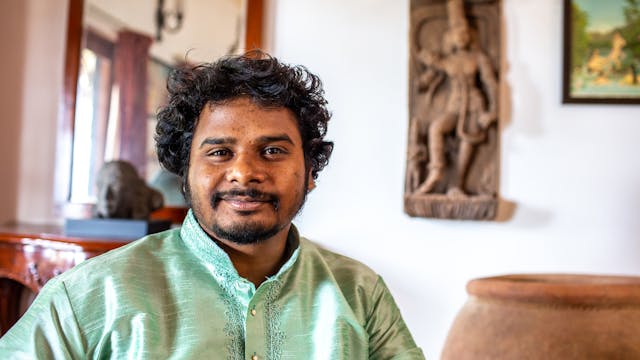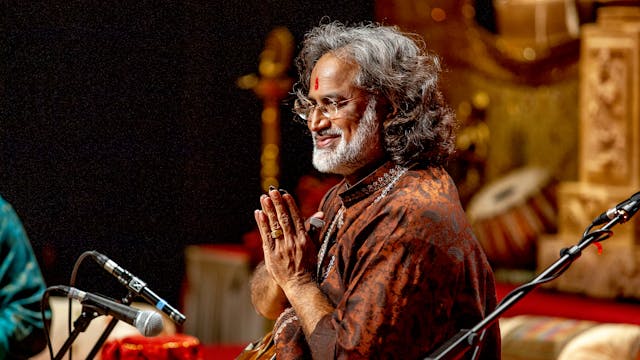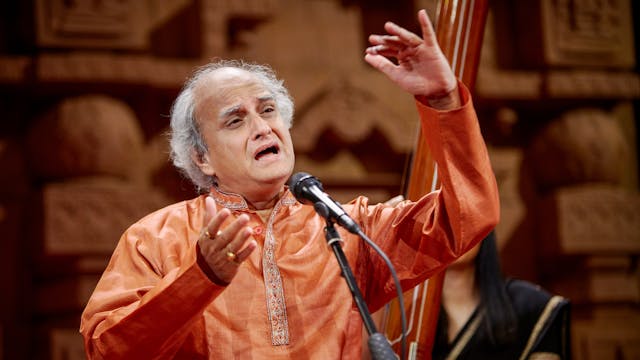Budhaditya Mukherjee | Raag Hameer
Evening Ragas
•
14m
Recorded live at the Bawali Rajbari, Kolkata
Musicians:
- Pandit Budhaditya Mukherjee (sitar)
- Soumen Nandy (tabla)
Raag Hameer, Thaat: Kalyan, Samay: early evening
Shot in an opulent heritage palace in Bawali located about 35 kilometres outside the periphery of Kolkata, this video seeks to bring the intimate ambience of a ‘baithak’ - a private soiree – to audiences. Till the earlier part of the 20th century, Indian classical music was a key element that constituted the environs of a palace like this owned by ‘zamindars’ or land-owners.
In this 14-minute 49-second recital, Pandit Budhaditya Mukherjee plays Raag Hameer with Soumen Nandy delivering a vivacious accompaniment on the tabla. As the performance progresses, a thunderstorm ensues in the background with dark, monsoon clouds scudding all over a dull-gray skyscape over Kolkata.
An early evening raga, Hameer’s sweet and candid appeal creates a deceptively easy-going countenance on the surface. However, its core qualities are laid out on dramatic complexity of tonal movements. Hameer’s identity is hidden in the succinct way of expressing Dha (6th) through a curvaceous path led through Ni (7th) on the melodic line. To witness this dynamic graph of melodic stress and relief within a 15-minute span is magical and only possible in the masterful hands of a musicians’ musician like Pandit Mukherjee.
He performs a short alap, a gat in madhyalay Rupak taal (7 beats) and then proceeds to play another gat in drut Teental concluding with a jhalla. During the melodic elaboration in slower tempo, he minces no word to expose the kernel of the raga, creating a solid ground to immediately deploy electrifying taans in the faster composition.
Nandy accompanies efficiently with tasteful solos in between to further liven the melodic grandeur. His interaction during the jhalla is courageous with crisp trills.
Hameer is known for its special gait and vast scope for elaborations. It belongs to the parent scale Kalyan and its jati is vakra-sampurna which makes it deviatingly heptatonic. The dominant note or vadi swar is Dha (6th) and the sub-dominant or samvadi swar is Ga (3rd). All the swars are pure except for a fleeting teevra Ma (sharp 4th) and komal Ni (flat 7th). Its arohana and avarohana are as follows:
S, R S, G M D, N D S’
S’ N D P, m P D P, G M R S
It applies the same notes as Chayanat, Kedar and Kaamod and yet maintains its distinct identity by laying emphasis on Dha (D) in a unique fashion, touching Ni (N) before coming down to rest at Pa (P). Like the deviously employed Teevra Ma (m), vivaadi or dissonant Komal Ni (n) is also touched once in a while to add to its beauty and emotive appeal. Its pleading phrases give it a devotion dipped romantic character.
Up Next in Evening Ragas
-
Ramakant Gaikwad | Marwa
Filmed and recorded live at Mulshi, Maharashtra
Musicians:
- Ramakant Gaikwad (khayal)
- Ramkrishna Karambelkar (tabla)
- Abhinay Laxmikant Ravonde (harmonium)
- Gayatri Gaikwad & Dr. Aparna Shenoy (tanpuras)Raag Marwa, Thaat: Marwa, Samay: sunset
Recorded live against the stunning, rugg...
-
Vishwa Mohan Bhatt | Gawati
Recorded at Darbar Festival 2007, on 14th April, at the Phoenix Theatre, Leicester.
Musicians:
- Pandit Vishwa Mohan Bhatt (mohan veena)
- Pandit Yogesh Samsi (tabla)Raag Gawati, Thaat: Khamaj, Samay: Late Afternoon
Pandit Vishwa Mohan Bhatt gives a soulful rendition of a this evening raag, ...
-
Pandit Ulhas Kashalkar | Darbari Kanada
Recorded at Darbar Festival 2011, on 24th April, at King's Place.
Musicians:
- Pandit Ulhas Kashalkar (vocal)
- Pandit Suresh Talwalkar (tabla)
- Chinmay Kolhatkar (harmonium)
- Sameehan Kashalkar (supporting vocals and tanpura)Raag Darbari Kanada; Thaat: Asavari; Samay: Midnight
Darbari...



